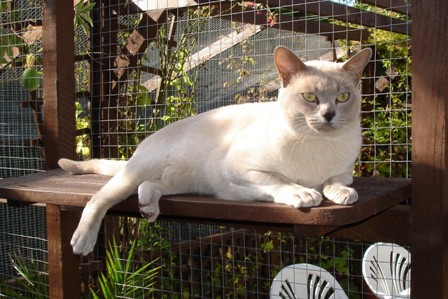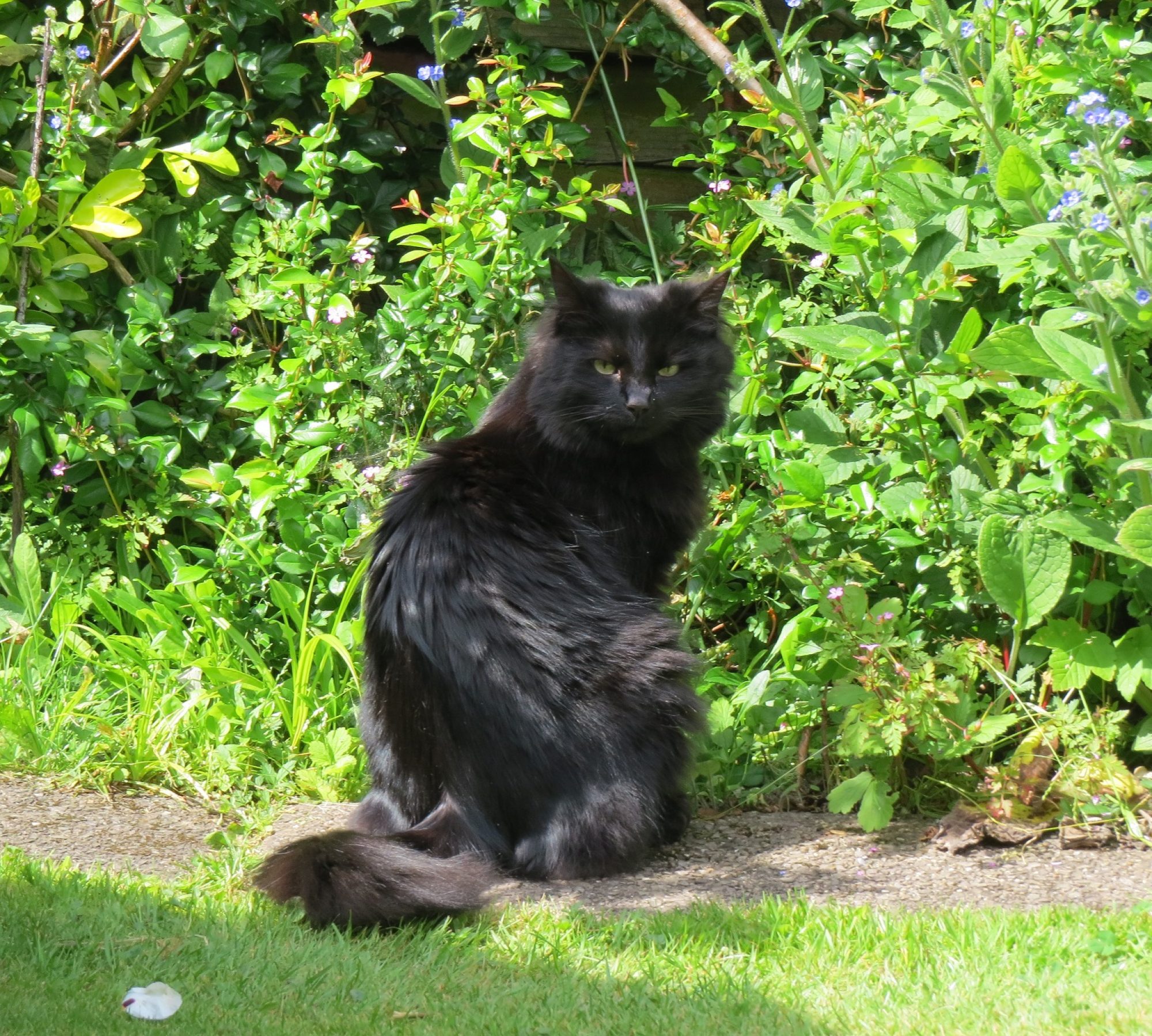The Burmese is a breed of domesticated cats split into two subgroups: the American Burmese and the British Burmese. Most cat registries do not recognise a split between the two groups, but those that do formally refer to the type developed by British cat breeders as the European Burmese. The Burmese was first recognized as a distinct breed in America in 1936 by the Cat Fanciers’ Association. Owing to the extensive breeding with Siamese cats that had been used to increase the population, the original type was overwhelmed and registration was temporarily dissolved during the 1940s. The breed was recognized by the UK Governing Council of the Cat Fancy in 1952. In 1953, after years of selective breeding, Burmese cats in America once again conformed to type and were recognized.

but have softer, sweeter voices”
Originally, Burmese cats were exclusively brown (sable), but years of selective breeding have produced a wide variety of colours. Different associations have different rules about which of these count as Burmese.
Burmese cats are known for being sociable and friendly with humans, as well as intelligent. They are very vocal, and often call to their owners.
Throughout the modern history of Burmese, there has been much breeding with Siamese leading to such give-aways as blue or green eyes in the normally yellow-eyed breed. In fact, the Tonkinese cat is a now-recognised cross between Burmese and Siamese.
Characteristics.
The Burmese is considered a foreign shorthair in the United States. Accepted eye colour for the breed is gold or yellow, although interbreeding with Siamese may lead to blue or green. The coat is known for being glossy, with a satin-like finish. As with most short-hairs, it requires no additional grooming. The shape of the British breed is more moderate but must not be Oriental, while the American breed is sturdier in build. Longer lived than most pedigree cats, they often reach 16 to 18 years of age.
Burmese are vocal like the Siamese but have softer, sweeter voices. They are people oriented, forming strong bonds with their owners, gravitating toward all human activity. The CFA breed information on the Burmese implies that all survival instinct of flight or fight seems to have been bred out of them. However, other sources note that, while rarely aggressive with humans, Burmese cats tend to be able to defend themselves quite well against other cats, even those larger than themselves.
Burmese maintain kitten interests and energy throughout their adulthood and are very athletic and playful. In some instances they even retrieve items as part of a game. Although all cats are obligate carnivores, some Burmese will sample fruit and vegetables.
History.
The earliest records of the type now known as Burmese come from Thailand, then known as Siam. A series of 17 illustrated poems written in Siam during the period of the Ayudhya mention three types of cat which appear to correspond to known breeds. These were the Vichien Mat (Siamese), the Si-Sawat (Korat) and the Thong Daeng (Copper, now known as Burmese). These cats are thought to have remained in Thailand until it was invaded by the Burmese in the 18th century; returning soldiers may have taken the temple cats with them back to Burma.
In 1871, Harrison Weir organised a cat show at the Crystal Palace. A pair of Siamese cats were on display that closely resembled modern American Burmese cats in build, although Siamese in marking. After this, cat fancy began with cat clubs and cat shows forming, although it took many years for breeds to be worked-out and developed. The first Burmese cats in the late 19th century in Britain were considered Chocolate Siamese rather than a breed in their own right, and this view persisted for many years, encouraging cross-breeding between Burmese and Siamese and attempts to breed Burmese to more closely conform with the Siamese build. The breed slowly died out in Britain.
Dr. Joseph Cressman Thompson imported Wong Mau, a brown female cat, into San Francisco in 1930. As had happened earlier, many breeders considered the cat simply to be a colour variant of the Siamese, but Dr Thompson considered the build sufficiently different to be something else. Without any male of a similar type, Wong Mau was bred with Tai Mei, a sealpoint Siamese from Thailand. Wong Mau was then bred with her son to produce dark brown kittens that were called Burmese cats. In 1936, the Cat Fancier’s Association granted recognition to the Burmese breed, but withdrew this in 1947 owing to the breed being mixed with Siamese and hybrid kittens being sold as pure. By 1953 the Burmese Cat Society of America had brought the situation under enough control for recognition to be restored.[6]
The breed didn’t take off in Britain until after 1945, when soldiers returning from Burma brought home cats. From about 1949 to 1956, the British Burmese population was being enriched with cats imported from America. The cats which fed the British breeding programme were of a variety of builds. By 1952, three generations had been produced in Britain and official recognition was granted by the Governing Council of the Cat Fancy and the breed was accorded the breed number 27. Until the late 1960s, the gene pool in Britain was very small, with most Burmese being descended from 6 initial imports and a Burmese/Chinese hybrid from Singapore. In 1969, more were brought over from Canada, and the genepool was widened.
The first blue Burmese was born in 1955 in England. This was to be followed by red, cream and tortoiseshell kittens over the next couple of decades. Much effort was put in to remove banding patterns from the coats, and to decide whether these new colours counted as Burmese. Champagne coloured cats (known as “chocolate” in the UK) appeared in America, but breeding was impeded by the refusal of breed clubs to acknowledge that Burmese cats could be any colour other than Brown. In 1971, the first lilac kitten was born, being the latest solid colour introduced in Burmese. Throughout the 1970s, brown, chocolate (champagne), blue and lilac toroiseshell types were developed in England. These are still not accepted by the Cat Fancier’s Association in America. Cinnamon, Fawn, Caramel and Apricot Burmese were developed in New Zealand from a breeding programme initiated by geneticist Dr Rod Hitchmough. The first cinnamon Burmese was Arsenios Cinnamon Dream Boy.
From the 1950s onwards, countries in the Commonwealth and Europe started importing Burmese cats from Britain. As a result, most countries based their Standard of Points for this breed on the British model, rather than the American.
Varieties.
As a result of these separate breeding programmes, British Burmese are different from American Burmese. The British build tends to be more Oriental, with a more triangular face, while the American Burmese is stockier and rounder in the body, head, eyes and feet. It has markedly full cheeks and a short muzzle, sometimes called “pug-like”. In the British type, both the American Burmese’s “cobbiness” and the obvious Siamese influence long seen in the breed are today considered grave, even disqualifying faults.
Ever since varieties other than sable/brown have existed, there has been conflict in the world of cat fancy as to which varieties are considered Burmese. In Britain, all the colours listed below are recognised by the Governing Council of the Cat Fancy, Britain’s ruling cat association. In the USA, which colours are acceptable depends on which cat registry the cat is registered with. For example, the Cat Fancier’s Association only recognises the first four colours below. All varieties should gradually shade from darker backs to lighter underparts. There should be no barring or spotting.
* Brown (UK) or Sable (USA)
* Blue
* Chocolate (UK) or Champagne (USA)
* Lilac (UK) or Platinum (USA)
* Red
* Cream
* Brown Tortoiseshell
* Chocolate Tortoiseshell
* Lilac Tortoiseshell
* Blue Tortoiseshell
Varieties with more limited recognition
* Cinnamon
* Fawn
* Cinnamon Tortie
* Fawn Tortie
* Caramel
* Caramel Tortie
* Apricot
Genetics
The Burmese Brown coat is caused by the Burmese gene (cb), part of the albino series, which causes a reduction in the amount of pigment produced converting black into brown, and all the other colours into a paler, more delicate shade of their full colour equivalents. The action of the gene causes pigment production to be most limited in the warmest parts of the body, so in some varieties darker areas of pigment are obvious on the colder parts of the body such as the face and ears, the tail and the feet. The effect of restricted pigment is significantly more visible in young kittens.
The Burmese gene is also present in some other cat breeds, partcularly the established rex breeds, where it can be fully expressed in its homozygous form (cbcb) and referred to as Burmese Colour Restriction or Sepia, or can be combined with the Siamese gene (cbcs) to form Mink or Darker Points. The Singapura is always homozygous for the Burmese gene, combining it with a ticked tabby pattern and Snow Bengals with eye colours other than blue also have the gene. A breed of cat exists called the Asian which is a sister breed to the Burmese, having the same physical type, but occuring in a range of other patterns and colours not recognised as part of the Burmese breed.
Controversy
For the past thirty years, there has been controversy over the appearance of the breed, which can now be divided into two camps. American breeders prefer the “contemporary Burmese” (“American Burmese”) which has shorter noses and rounder skulls. The “traditional Burmese” (or “British Burmese”) was declassed by the CFA in the 1980s. England’s GCCF took the opposite approach and banned the registration of “contemporary Burmese” in order to preserve the “traditional” bloodlines.
The controversy revolves around the fact that “contemporary Burmese” sometimes carry alleles for the Burmese Head Fault, a lethal head defect; affected kittens do not survive long. This problem does not generally occur with “traditional Burmese”. Its widespread presence in the American lineages goes back to a cat named Good Fortune Fortunatus, a fine example of the “contemporary” body/head type. This individual was extensively mated to Burmese cats in the USA, and today’s show-type American Burmese cats can usually trace their lineage back to it.
Unfortunately, Good Fortune Fortunatus did not only carry the alleles for producing the much-desired stockier body and round head, but also for the fatal condition which seems to be related to the head shape. “Contemporary Burmese” Breeders feel justified in continuing with their stock because defective kittens are euthanized before they are of age to be sold. Despite the contribution of Good Fortune Fortunatus to today’s American Burmese gene pool being extensive – the fatal allele was essentially spread throughout all American Burmese lines -, it is hoped that the head fault is not too closely linked to alleles confering the desired “modern”-type anatomy and that the “head fault” allele will eventually be eliminated by years of controlled breeding.
Leslie A. Lyons, Ph.D. from University of California, Davis is doing research to locate the gene that is causing this mutation. Resolving these problems would be highly useful, as the “head fault” allele appears to be expressed in recessive or epistatic manner. Therefore, eliminating it from the gene pool by simply culling affected animals is likely a prolonged process, if it can at all be successful (recessive alleles are rarely ever entirely eliminated from all but the most inbred gene pools). Genetic screening for the presence of the allele would enormously speed up the process if the allele is not closely liked to the type’s defining features, and prevent much suffering as the birth of animals doomed to an unpleasant death could be avoided or at least much reduced.

